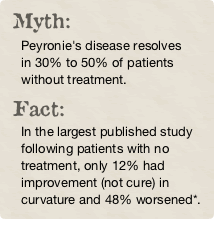Treatment Options

Doctors have tried many different treatments for Peyronie's disease since it was first described in 1678. The most common treatments can be divided into two basic categories, invasive and non-invasive.
Invasive treatments include:
- Injections of verapamil, interferon, or purified clostridial collagenase into the plaque
- Various stretching devices
- Surgery- usually performed as a last resort due to potential unfavorable outcomes such as impotence and loss of penile length. Penile prosthesis is an option if the patient has severe erectile dysfunction.
Non-invasive options include:
- Transdermal Verapamil 15% Gel
- Iontophoresis of different drugs
- ESWT- Extracorporeal Shock Wave Therapy
- Oral Medications such as vitamin E, colchicine, paraaminobenzoate (Potaba®), tamoxifen, and acetyl-L carnitine
Most doctors agree that a conservative approach to treating Peyronie's disease is preferred. As a result, the least invasive options are typically tried first before moving to invasive procedures or surgery in patients suffering from the most significant cases of Peyronie's disease.
*An Analysis of the Natural History of Peyronie's Disease Mulhall JP, Schiff J, Guhring P The Journal of Urology- 2006 06 (Vol. 175, Issue 6)